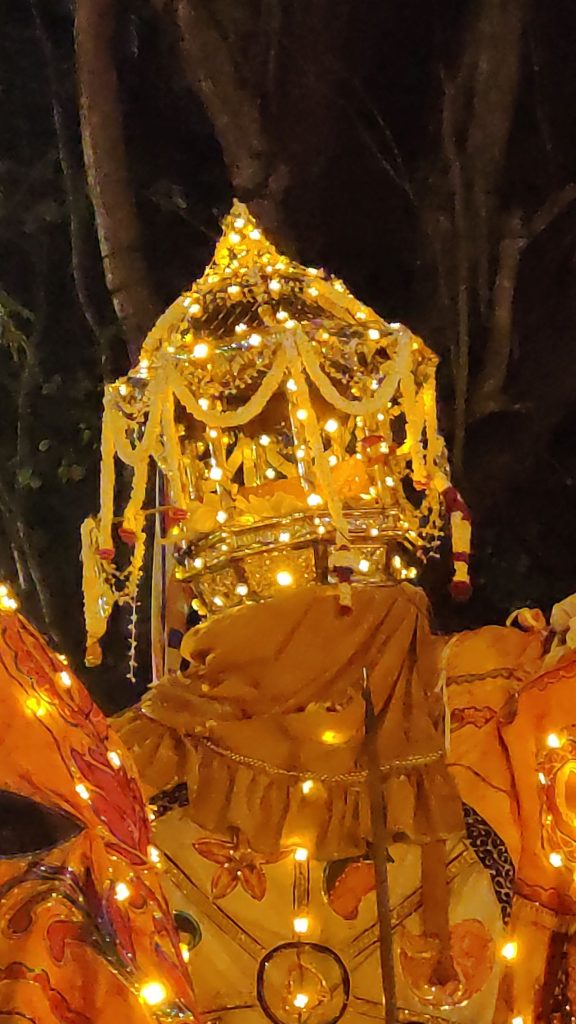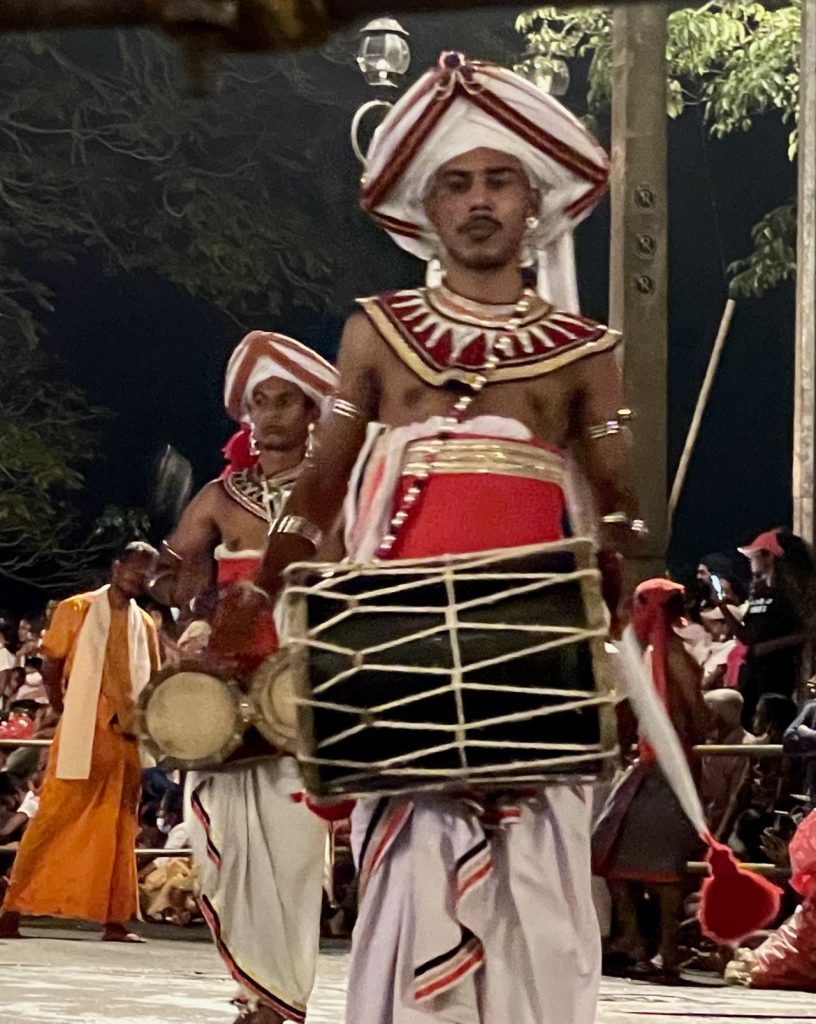
Our entire trip to Kandy was to experience the larger-than-life pageant of the Kandy Esala Perahera and as I saw the pageant unfold in front of our eyes, I understood why the Tooth Relic is worshipped as a form of Living Buddha himself. The Perahera is an offering made to the Sacred Relic and the temple itself is a microcosm of the mystical traditions and rituals that surround the relic. It was a flamboyant, dramatic, breathtaking, highly energetic, traditionally evocative pageant with dance, music, drama, and elephants, celebrated by the Temple of Tooth Relic in Kandy as an annual spiritual ritual.

Dalada Perahera also known as the Kandy Esala Perahera is usually celebrated in the month of Esala (July) and it is the very epitome of Buddhist traditions and it is one of the oldest cultural pageants of Srilanka. The festivities started as a ritual in Anuradhapura where the relic was earlier housed and it was believed to be celebrated to bring good harvest and prosperity to the region. It has been performed across eras in different towns where the temples housed the relic to display the patronage and reverence given by the monarchs who were the guardians.

The festival which has been continuously celebrated for over 1500 years pays homage to the Tooth Relic and Buddha and the guardian deities. While dancers and drummers steal the show with elephants, the Kandy Esala Perahera Casket containing the tooth relic parades the streets of Kandy and is worshipped by everyone, including the pachyderms who are part of the parade.

Historically it is believed that Samrat Ashoka of Kalinga in India started the traditions of the Perahera. The Kandy Perahera is a blend of both Buddhist and Hindu customs and rituals and it lasts for 12 days. The first day is referred to as ” Kap”, a ceremony where a sapling of a jack fruit tree is planted in front of the four shrines or Devalayas – dedicated to the four guardian gods of the sacred relic – Natha, Vishnu, Katharagama, and the goddess Pattini. In fact, the pageants include processions to them as well, where palanquins are brought out as a part of the parade as well. The first parade is called Kumbal Perahera, and it continues for five days. Although the pageants are not grand, the dancers participate without much fanfare with the tuskers. They are however revered as they are believed to remove evil spirits,


The Randoli Perahera follows the Kumbal Perahera as the drummers and dancers along with the tuskers parade the streets of Kandy for four days, finally culminating in the Grand Rangoli Perahera, an event to behold. Each procession is for three hours and there are five processions, dedicated to the Sacred Relic and the four guardian deities.


Dancers and drummers in their ceremonial costumes and gold and silver jewellery and elephants in gold studded costumes – some weighing over 35 kgs. While all the parades are in the evening, there is a day perahera on the final day of the festival, which is a closing ceremony. The last day is also known for the water-cutting ceremony called Diya-kepeema ritual, which is held at the Mahaweli River. The route changes every day but they are cleansed with turmeric water and helpers walk with traditional lanterns made with dried white flesh of the coconuts.


We were there for the Grand Rangoli Perahera, where the divine energy coupled with the vibrant atmosphere made it one of a lifetime experience. The entire streets of Kandy were thronged with over 10000 people, and most of them brought blankets, chairs, and even snacks. We were seated right in front of the Sacred Tooth Relic at the entrance of the legendary Queen’s Hotel. The former Governor’s Residence has been converted into a colonial-style hotel and some tourists had even checked into the hotel to watch the Perahera from their room balconies.

There were whip crackers and fireball dancers and acrobats followed by the Buddhist and other flags and sword bearers. The very first elephant was followed by Kandyan dancers, drummers, and trumpeters and then there were several groups of musicians and dancers with more elephants dressed in grand costumes. Some of the dancers are referred to as Yak Tail dancers, Wood Stick dancers, Pantheru, Havadi , Nayyandi, Sword dancers, Ves dancers among others, dressed in their finery with jewellery and costumes. Ves refers to the elaborate and stunning head gear with jewels worn by the master dancer, who need to earn the status after years of training.


The reverberating beats of the “Getabera” the traditional Kandyan drum set the rhythm for the “Gajaga Wanama” the dance that represented the gait of the elephant. They were followed by the Royal Tusker which brought the Sacred Casket and the first pageant ended with the Maligawa tusker accompanied by the Diyawadana Nilame, who was the designated guardian in the absence of the king.


This was then followed by the processions by the four Devalayas – Natha followed by Vishnu, Kataragama, and Patini Devi. Female dancers were allowed only in the last procession of Patinidevi. There was a colour scheme for every procession and even the dances were performed in a pattern. The entire pageant continued till midnight as the Perahera paraded through the city for over four hours. I was told there were over 7000 performers besides 100 drummers and 50 elephants who were part of the procession.

The entire experience left me spellbound and made me realize how blessed I was to witness such a once-in-a-lifetime experience. Besides the pageant, we also went behind the scenes to little hamlets around Kandy to see the preparations for the Perahera. The actual travel story was deconstructing the festival, traditions , music , the crafts, the costumes and discovering the stories behind them.


On the first day, we left Colombo for Kandy and on the way, we visited the home and dance academy of Shri Ravi Bandhu and his family. Dancer, percussionist, painter, choreographer and teacher, he, along with his son took us into a world of music and dance, the traditions, the nuances. We learnt all about the Kandyan dance, the drums, the beat, and the rhythm besides learning more about the festival itself and the legends behind it. We followed it with a visit to a unique drum village called Kurugala where the entire hamlet is dedicated to the craft of making different drums or “Bera” as they are called. Besides the legendary Geta Beraya, we also saw other varieties like Davula, Thammattama and Yak Beraya. Each drum was different and was made of different wood and leather and it produced a unique beat.


The elephants participating in the Perahera had grand costumes created for them with magnificent embroidery and we went to a village called Geli Oya near Kandy to a factory called Wishlan Apparel to see some of the embroidery being made for the elephants.

The entire set of fabric was over 30-35 kgs and there were over six separate pieces for the elephants, including the trunks and body. Each design was based on a theme and it would vary from flowers to peacocks to even people. Each elephant had a unique design and the colours were decided well in advance keeping in the mind the various processions and pageants which were part of the Perahera.

Most of these elephants I was told were orphaned and rescued and have been either taken care of in the orphanages or individuals or from the temples. Elephants are part of the cultural and spiritual fabric of Srilanka and in the Kandy Esala Perahera, the elephants were revered as well.

Finally, all that glitters is brass in this village near Kandy. Villages are the heart of any country and in Srilanka, villages are where the real stories unfold. In this village called Kiriwaula, all that glitters is brass although it’s as valuable as gold for the people.Brass is one of the most precious metals and almost every brass article for temples, be it lamps or locks, and items used for their festivals and ceremonies are sourced from this village.
We visited two workshops, where brothers Kumar and Vasindha showcased some of the articles they were carving out of brass for the Kandy temple and the Esala Perahera.

One of the many reasons I loved this itinerary was how everything eventually led to the festival. We explored hinterland Srilanka to meet the various artisans whose lives and livelihoods revolved around the Esala Perahera. And the pageant was absolutely all-pervading and larger than life as well as you can see from the rituals and dances.
I am grateful to Srilankan Airlines for having organized this trip and for showcasing how safe it was also for tourists to travel to Srilanka and also participate in a grand pageant.


